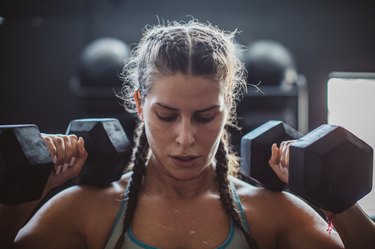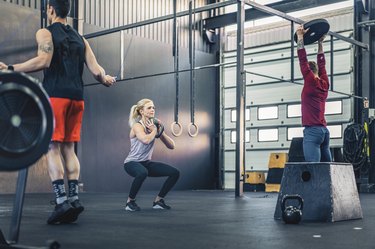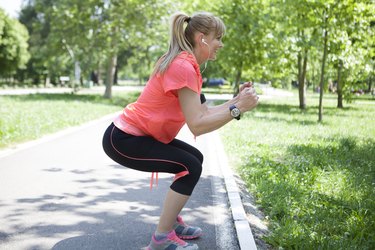
If you're new to lifting, it can be hard to choose which dumbbells you need for your workouts — but finding the right weight is essential. Too much and you'll set yourself up for injury, too little and you won't be getting much benefit from your efforts.
There are two main things to consider when it comes to choosing what weight dumbbells you should use: what exercises you're doing and what your fitness goals are. Of course, you also need to consider your current level of strength and experience to avoid injury and maximize gains.
Video of the Day
Video of the Day
Poundage for Beginners: Getting Familiar With Dumbbell Weights
Dumbbells range in weight from 1/2-pound up to about 50 pounds. When you're starting out with a dumbbell routine, you're going to have to play around with different weights in order to find the ones that fatigue your muscles. The right dumbbells for a beginner to use are ones that make the exercise feel challenging but doable.
Form should always be your top priority when you're performing any kind of dumbbell exercise, Cameron Yuen, DPT, CSCS, physical therapist at Bespoke Treatments, tells LIVESTRONG. Toward the end of your sets, you should feel fatigued but not so much that your form breaks down. To figure out what that is, you can think about your repetition maximum (RM), or the maximum weight you can move in a given number of reps. If you're planning to do 10 reps, you should be lifting a weight heavy enough to really max out your strength by that final rep. That's roughly your 10RM.
If you've never used dumbbells before, it's best to start with lower weights — for some people, that might mean 3 or 5 pounds, while for others that might mean 10 or 12 — so you can adjust to the shape of your dumbbells, become accustomed to holding them in your hands during exercise and learn proper form and technique before advancing to heavier weights. Always start with body-weight exercises and become an expert on form before adding in dumbbells (or any other weight).
While there's no single average dumbbell weight for beginners, most experts recommend not increasing total exercise volume by more than 10 percent per week. Don't worry. You don't have to do the math. Just keep things gradual. So once you've mastered body-weight squats, take on 10-pound weights before trying out 25s.
There's really no way of saying exactly how heavy dumbbells should be, because it varies so much by person. For instance, someone who is new to lifting but already generally healthy and active may be able to start with 25-pound dumbbells for a compound lower-body exercise like a sumo squat. Meanwhile, someone who is rehabilitating an injury may need to start with 5- or 10-pound dumbbells.
To get a feel for the right weight, start by going to a gym, picking a weight off the rack and seeing how it feels in your hand. If it feels heavy when you pick it up, it's probably going to be too heavy to do a full set.
If it feels easy to lift, do a test run. Try to do 10 reps, focusing on how you feel and how easy it is to maintain proper form. If you aren't able to complete all of your reps with good form, try smaller dumbbells. If you can easily perform 10 more reps with good form, choose heavier dumbbells. The sweet spot is being tired after those 10 reps but still able to push out 1 or 2 more reps if you absolutely had to.
Beginner Dumbbell Sets We Like
- Amazon Basics Neoprene Coated Dumbbell Hand Weight Set (Amazon.com, $49.99)
- JFIT Dumbbell Hand Weight Pairs and Sets (Amazon.com, $43.56)
- Sporzon! Colored Neoprene Coated Dumbbell Set with Stand (Amazon.com, $49.99)
How Dumbbell Weights Differ From Exercise Machine Weights
If you have experience with exercise machines, know that dumbbell exercises are more unstable — you don't have a large piece of equipment making sure the movement stays within a specific range of motion — so the exercises might feel more difficult.
But instability can also mean risk. "If you get injured, you can't train, so always think of safety first," Yuen adds.
"While you can use the barbell or machine weight you lift as a [benchmark], you should aim for 20 percent less when opting for a dumbbell," he explains. "This works well as a rule of thumb, but as you get more comfortable with the instability, you can go for heavier weights."
For example, if you squat 135 pounds total, you'll likely want to grab a pair of 50-pound dumbbells (100 pounds total), which is about 20 percent less in total weight.
If you're a total beginner and don't have a pre-existing benchmark weight from machine exercises to figure out the best weight of dumbbells, that's OK. Use the guidelines below to figure out your perfect weight.
Tip
Find a pair of dumbbells that feels comfortably challenging. You should be able to finish all of your reps with good form. If you're fatiguing halfway through a set, choose a lighter set.
How to Choose Dumbbell Weight By Exercise
Selecting dumbbells is a bit of a Goldilocks experience: Too light, and you won't give yourself the challenge you need. Too heavy, and you won't be able to complete your reps with proper form. So how do you find the perfect pair?
To find the right dumbbell weight for you, you'll need to first consider the types of exercises you'll be doing with the weights.
Ideal Dumbbell Weight for Lower-Body Exercises vs. Upper-Body Exercises
Thanks to the large muscles like the glute and quads, most people are stronger doing lower-body exercises than upper-body exercises. Which means you'll likely be able to use heavier dumbbells for exercises like squats, deadlifts and lunges than for shoulder presses, bent-over dumbbell rows and scaption raises.
If you're doing a workout that involves both upper- and lower-body exercises, you'll want to have a heavier set and a lighter set nearby to use depending on the exercise. Because, for example, a 30-pound dumbbell might be appropriate for a squat, but way too heavy for a shoulder press. Again, you have to sort of gauge how you feel as you go and switch out your weights when you find you can't really do a move with your best form.
Ideal Dumbbell Weight for Isolation vs. Compound Exercises
The dumbbell size you need will also vary by exercise. Generally speaking, you'll be able to use a heavier weight for compound exercises, which involve multiple muscle groups and joints, than you will for isolation exercises, which target one specific muscle or muscle group.
With the bench press, for example, you're using your chest, shoulders and arms to press the dumbbells upward. Using all of those muscles at once, called a compound exercise, means you'll have more power behind the move, and you'll be able to lift more weight. But for a triceps extension, you're really only using the triceps muscles of the arms, so you may not be able to lift quite as much weight.
Same goes for say an overhead press and a lateral raise — you'll probably find you can use a heavier weight for the former but need to drop some pounds for the latter. That's normal, and important to do to avoid injury.
As a general rule, err on the light side. For example, you might choose an 8- or 10-pound dumbbell for biceps curls and a set of 20-pound weights for bench presses. If that feels really light as you're getting through the set, you'll know to move up in weight for the next round.
How to Choose Dumbbell Weight by Goal
How much weight you should lift also depends on why you're strength-training — whether you're lifting weights for increased strength and endurance, for example, or for power.
When you're just starting lifting, you might not have any goal beyond that. In that case, just doing one set of about 8 to 12 reps of each exercise is adequate to help you build muscle and develop some initial strength and skill wielding weights.
But as you start training with specific goals, you'll want to be more strategic, which will influence how heavy or light you'll go with your dumbbells. Keep reading to learn how to adjust your weights for different goals.
Dumbbells to Increase Max Strength
Dumbbell Selection: Heavy
- Reps and sets: Compound exercises: 2 to 6 sets of 6 or fewer reps; Isolation exercises: 1 to 3 sets of 8 or fewer reps
- Weight selection: heavy
If your goal is to simply build brute strength — lift a large amount of weight in one go — then you want to go very heavy.
The recommended reps and sets for building max strength are:
- Compound exercises: 2 to 6 sets of 6 or fewer reps
- Isolation exercises: 1 to 3 sets of 8 or fewer reps
When choosing dumbbell weight, you want to choose dumbbells that allow you to completely fatigue your muscles in just 6 or 8 reps, with the last two reps being extremely difficult, but doable (without totally fudging your form).
If you're a beginner, it's best to start with lighter weights and more reps to avoid hurting yourself before you're totally ready to move large loads efficiently. For that reason, hypertrophy (coming up next) is a better goal to start with.
Dumbbells to Increase Muscle Size (aka Hypertrophy)
- Reps and sets: 3 to 6 sets of 6 to 12 rep
- Weight selection: moderately heavy
Hypertrophy training is all about building muscle size, though this type of training will also build strength if you're a beginner (you just won't get powerlifter-like strength gains unless you train like a powerlifter, for max strength).
The recommended reps and sets to build muscle are 3 to 6 sets of 6 to 12 reps. Many standard workout programs that you'll find online are in this range.
When you're doing reps and sets in this range, you want to choose dumbbells that are moderately heavy — light enough that you can get through the reps and sets, but heavy enough that your muscles feel challenged in the first set and totally fatigued by the end of the final set.
So, if you're just starting out with dumbbell training, you might opt for one 20-pound dumbbell or two 10-pound dumbbells for a squat or bent-over row.
Dumbbells to Improve Muscular Endurance
- Reps and sets: 2 to 3 sets of 12 or more reps
- Weight selection: light
Muscular endurance means that your muscles are able to work against resistance for an extended period of time (think: running, biking, or any other activity that has you moving for a long time).
The recommended reps and sets for muscular endurance are 2 to 3 sets of 12 or more reps.
For endurance work, your dumbbells should be light — so that you can do 12, 15, even up to 20 reps. The goal here is to keep your muscles under constant tension, so the weight you use needs to be sustainable.
For example, a beginner training for muscular endurance might start with 2- to 3-pound dumbbells in each hand and perform 12 to 15 repetitions of exercises like lateral raises, hammer curls, and triceps extensions.
How to Know It’s Time to Increase the Weight
Once you find that "sweet spot" of dumbbell weights that are not too light but not so heavy, write down the amount you're lifting for each exercise in a workout journal. That way, you'll know what size weights to use the next time.
It'll also help you keep track of when it's time to lift heavier.As a general rule, increase weights by the smallest increments you have available. If it ends up feeling too easy, you can always go heavier.
After about four to six weeks of lifting two to three times a week, you'll probably find that you need to move up in weight to continue feeling that fatigue toward the end of the set — that's you getting stronger. Also, be sure to mix up your routine so you're not doing the same exercises during each workout.
One downside to dumbbells is that you can only go so high. If you're progressing, increasing your weight as you get stronger and stronger, you may need to graduate to barbells, which can be loaded much higher than 50 pounds.
Related Reading
Shopping for Dumbbells
When figuring out what weight dumbbells you should buy, there are a few things you'll want to keep in mind. Dumbbells come in a variety of sizes and shapes. A single set of weights won't be too pricey, but the best size and style of dumbbells depends on your training goals.
Where Can I Buy Dumbbell Weights?
These days, you can find dumbbells just about anywhere, including retailers like Amazon, Target and Walmart. Unfortunately, though, weights tend to be a little pricey but you can shop strategically. Holiday sales are generally the best time to buy exercise equipment.
Dumbell Material
You can find dumbbells that are either iron or coated with some softer material, like neoprene or rubber. Thanks to their damage resistance, iron dumbbells are great for anyone who may be dropping them on cement (like your garage floor).
For those who like to keep their workouts indoors, coated weights are definitely best. The rubber surface can help protect your floors from damage just in case you happen to drop a dumbbell mid-workout.
Dumbbell Type
The bad news: There isn't a one-size-fits-all approach to dumbbells, as each person starts at a certain level and has different goals. The good news: Today, you can buy dumbbells in just about any size and form. Just make sure your weights are eligible for return or exchange if needed before you purchase a pair.
While standard dumbbell sets are the cheapest option, adjustable dumbbells may be more practical, Yuen says.
"[Adjustable dumbbells] have come a long way in terms of design and ease of use, so if you're looking for a home set, I would choose one of these," he says. "The three target weights listed above work well as standard dumbbell weights, but as you get stronger you will probably want to challenge yourself with increased weight."
Dumbbell Handle
Don't underestimate the importance of the dumbbell handle — after all, it's the part you're holding the most often. Smooth handles are definitely the most comfortable at first grasp but they can get slippery as you sweat or work with heavier weights.
For those lifting heavier weights, texturized handles are best. These have little ridges in the metal that help give you a better grip while you train.
Dumbbells have different handle widths, too. Wider handles can feel uncomfortable or difficult to grasp but they're a great way to build your grip strength.
Dumbbell Shape
You may have noticed dumbbells come in different shapes, too. Most commonly, you can choose between round or hexagonal weights. While they won't feel different when you lift them, hex weights are best for those who may exercise on non-flat surfaces, as they won't roll away.
Round weights, on the other hand, are great for those who love weighted carry exercises. As you walk with heavy dumbbells at your sides, the corners of hex weights can bump into your legs, causing discomfort. Round DBs have smoother edges and are less likely to leave a mark.
The Best Adjustable Dumbbells
- Bowflex SelectTech 552 Adjustable Dumbbell (Amazon.com, $399)
- PowerBlock Sport 24 Adjustable Dumbbell (Amazon.com, $317.54)
- NordicTrack Select-A-Weight 55 Lb. Dumbbell Set (NordicTrack.com, $499)
Additional reporting by Denise Stern, Bojana Galic and Nicole Vulcan.
Was this article helpful?
150 Characters Max
0/150
Thank you for sharing!
Thank you for your feedback!


